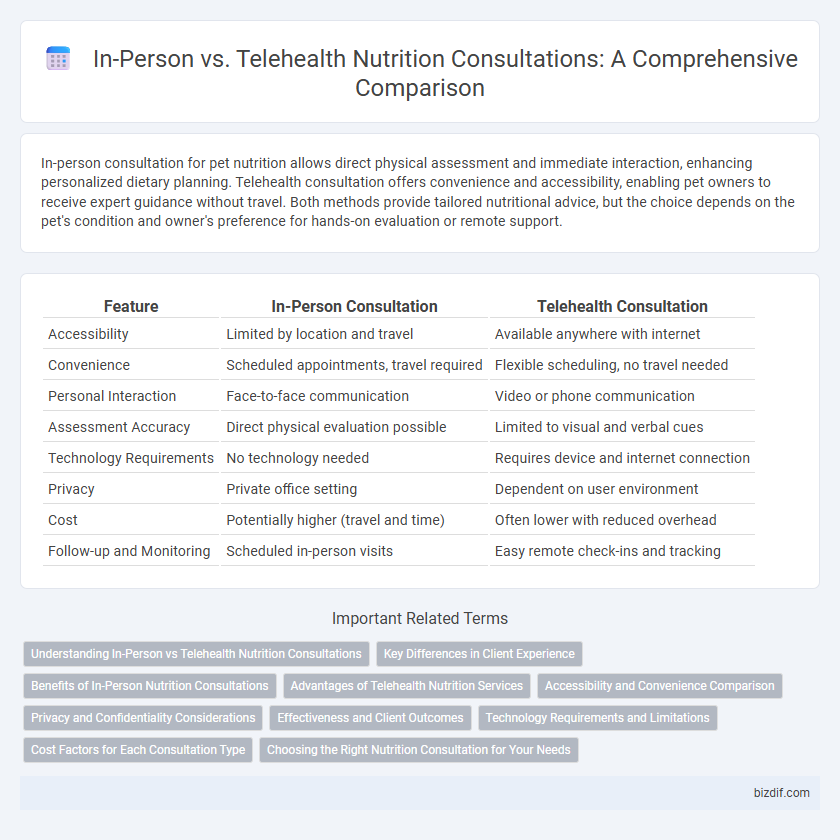In-person consultation for pet nutrition allows direct physical assessment and immediate interaction, enhancing personalized dietary planning. Telehealth consultation offers convenience and accessibility, enabling pet owners to receive expert guidance without travel. Both methods provide tailored nutritional advice, but the choice depends on the pet's condition and owner's preference for hands-on evaluation or remote support.
Table of Comparison
| Feature | In-Person Consultation | Telehealth Consultation |
|---|---|---|
| Accessibility | Limited by location and travel | Available anywhere with internet |
| Convenience | Scheduled appointments, travel required | Flexible scheduling, no travel needed |
| Personal Interaction | Face-to-face communication | Video or phone communication |
| Assessment Accuracy | Direct physical evaluation possible | Limited to visual and verbal cues |
| Technology Requirements | No technology needed | Requires device and internet connection |
| Privacy | Private office setting | Dependent on user environment |
| Cost | Potentially higher (travel and time) | Often lower with reduced overhead |
| Follow-up and Monitoring | Scheduled in-person visits | Easy remote check-ins and tracking |
Understanding In-Person vs Telehealth Nutrition Consultations
In-person nutrition consultations provide personalized, hands-on assessments, enabling dietitians to observe physical cues and conduct immediate measurements, which enhances diagnostic accuracy. Telehealth consultations offer flexible scheduling and access to nutrition experts regardless of location, utilizing video calls and digital tools for dietary analysis and education. Both methods prioritize individualized nutrition plans, but the choice depends on client preferences, accessibility, and the need for direct physical evaluation.
Key Differences in Client Experience
In-person nutrition consultations offer direct physical assessment and immediate, personalized interaction, enhancing the ability to observe non-verbal cues and adjust recommendations on the spot. Telehealth consultations provide convenience and flexibility, enabling clients to access services from any location while utilizing digital tools for food tracking and progress monitoring. The choice between these methods impacts client comfort, accessibility, and engagement, ultimately influencing long-term adherence to nutrition plans.
Benefits of In-Person Nutrition Consultations
In-person nutrition consultations provide personalized, hands-on assessments such as body composition analysis and physical examinations that telehealth sessions cannot fully replicate. The face-to-face interaction enhances communication, allowing dietitians to observe non-verbal cues and immediately adjust recommendations based on client responses. This method fosters stronger rapport and accountability, leading to improved adherence to dietary plans and better long-term nutritional outcomes.
Advantages of Telehealth Nutrition Services
Telehealth nutrition services offer unparalleled convenience, allowing clients to access expert dietary guidance from the comfort of their homes. This method eliminates travel time and geographic barriers, expanding access to specialized nutrition consultations for individuals in remote or underserved areas. Enhanced flexibility in scheduling and the use of digital tools for monitoring progress optimize client engagement and personalized care delivery.
Accessibility and Convenience Comparison
In-person nutrition consultations offer direct, face-to-face interactions that enhance personalized assessments and immediate feedback, particularly beneficial for complex dietary needs or physical health evaluations. Telehealth consultations provide greater accessibility by eliminating travel barriers and accommodating flexible scheduling, which is ideal for individuals in remote areas or with busy lifestyles. Both formats support effective nutritional guidance, but telehealth excels in convenience, while in-person visits prioritize comprehensive, hands-on evaluations.
Privacy and Confidentiality Considerations
In nutrition consultation, privacy and confidentiality considerations differ between in-person and telehealth formats, with in-person visits offering controlled environments where sensitive information is less vulnerable to digital breaches. Telehealth consultations require robust encryption and secure platforms to protect patient data from cyber threats, making compliance with HIPAA and other privacy regulations crucial. Both formats demand clear communication about data handling practices to maintain trust and ensure client confidentiality.
Effectiveness and Client Outcomes
In-person nutrition consultations often provide more effective communication through direct body language observation and immediate physical assessments, enhancing personalized client outcomes. Telehealth consultations offer increased accessibility and convenience, allowing for consistent follow-up and dietary monitoring, which supports sustained client engagement and adherence. Studies indicate both methods yield positive outcomes, but the choice may depend on individual client needs, with hybrid models emerging as optimal for comprehensive care.
Technology Requirements and Limitations
In-person nutrition consultations require minimal technology, relying primarily on face-to-face interaction and physical assessment tools, making them accessible to clients without advanced tech skills. Telehealth consultations depend heavily on stable internet connections, compatible devices such as smartphones or computers, and user familiarity with video conferencing platforms, which can limit accessibility for some individuals. Technical issues like connectivity disruptions or software glitches can hinder communication and the overall effectiveness of remote nutritional guidance.
Cost Factors for Each Consultation Type
In-person nutrition consultations typically incur higher costs due to overhead expenses such as clinic rent, utilities, and staff salaries, which are factored into the fee structure. Telehealth consultations often offer a more cost-effective alternative by reducing or eliminating these physical-location-related expenses, resulting in lower rates for patients. Insurance coverage and provider-specific pricing models also significantly influence the final out-of-pocket costs associated with each consultation type.
Choosing the Right Nutrition Consultation for Your Needs
Selecting the right nutrition consultation depends on your lifestyle, health goals, and accessibility. In-person consultations provide hands-on assessments, personalized meal planning, and direct interaction with a nutritionist, ideal for those needing detailed physical evaluations. Telehealth consultations offer convenience, flexibility, and remote monitoring, making them suitable for busy individuals or clients in remote areas seeking consistent dietary guidance.
In-Person Consultation vs Telehealth Consultation Infographic

 bizdif.com
bizdif.com